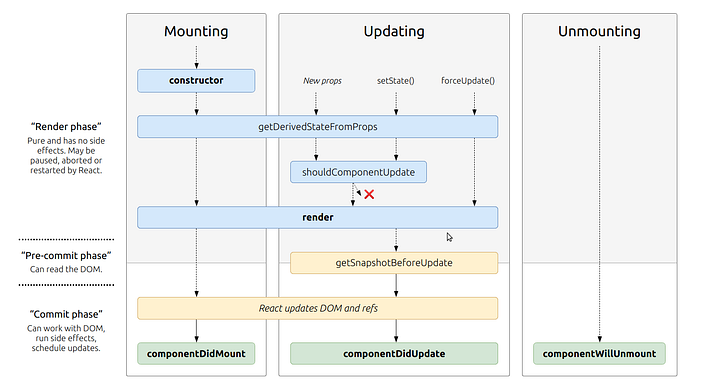React: States & Props
Readings
References
Questions
React Lifecycle
- Based off the diagram, what happens first, the ‘render’ or the ‘componentDidMount’?
Render occurs before componentDidMount in the order of operations
- What is the very first thing to happen in the lifecycle of React?
- Put the following things in the order that they happen:
componentDidMount, render, constructor, componentWillUnmount, React Updates
- Order of operations:
constructorstaticgetDerivedStateFromPropsrendercomponentDidMountUNSAFE_componentWillMount
- What does
componentDidMount do?
- Allows us to execute React code when the component is already in the DOM
React State vs Props
- What types of things can you pass in the props?
- Anything that can be treated as a variable by the component may be passed through as a
prop
- What is the big difference between props and state?
props are passed down to a component from the outside and set the initial state of the componentstate is internal to the component and updates internally within the component
- When do we re-render our application?
- When we change it properties or state, usually after a user input or a data update on a parent component
- What are some examples of things that we could store in state?
- Current count of a counter within a component
- When a user makes an input in a form, we can store the changes in state
Notes
React: Component Lifecycle Events

- Mounting
- Component gets created and inserted into the DOM
- Order of operations:
- Constructor
staticgetDerivedStateFromPropsrendercomponentDidMountUNSAFE_componentWillMount
- Updating
- Occurs anytime a component is updated or changes state
- Order of operations:
static getDerivedStateFromPropsshouldComponentUpdaterendergetSnapshotBeforeUpdatecomponentDidUpdateUNSAFE_componentWillUpdateUNSAFE_component WillReceiveProps
- Unmounting
- Component is removed from the DOM
- Uses
componentWillUnmount
React: State vs Props
props are like the arguments to a functionprops are passed into a componentstate occurs inside a componentstate updates within the component- When you change the state of a component, it will re-render on the webpage
- Use
state when:
- The piece of information that you are using will be handled inside the component only
- Use
props when:
- The piece of information that you are using is handled by a parent component
In-Class Notes